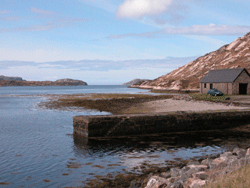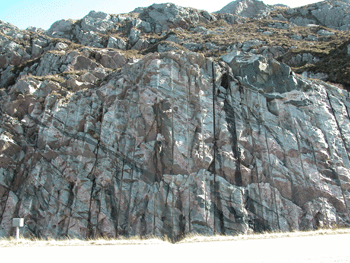
Mackay Country
Dùthaich Mhic Aoidh
An area in North-West Scotland of natural unspoiled beauty, rich in heritage & history
Laxford Bridge
Opposite the turn off for Tarbet is Loch a’Bhagh Ghainmhidh, the A894 passes Loch na Claise fearna before turning east you can look down on Weavers Bay where in 1848 after the potato famine nearly 500 people emigrated by boat to America.. A little further opposite the lay by at Badenbay, a tidal inlet of Loch Laxford are nine upright stones the remains of a Neolithic burial chamber.From Scourie the road north actually heads only a little north of east, towards Laxford Bridge, where you choose whether to continue on to Durness and the north coast, or take the road south east to Lairg. To the north the road turns northeast toward the long sea-loch of Loch Laxford, a large sea loch that lies 4 miles (6.5 km) northeast of Scourie.


From Scourie the road north actually heads only a little north of east, towards Laxford Bridge, where you choose whether to continue on to Durness and the north coast, or take the road south east to Lairg. To the north the road turns northeast toward the long sea-loch of Loch Laxford, a large sea loch that lies 4 miles (6.5 km) northeast of Scourie.
The main road continues to Laxford Bridge, a junction where the road from the south and the other southern gateway at Kinloch joins the west coast route having followed the wide valleys of Loch Shin, Loch Merkland, Loch More and Lock Stack. Unless the traveller is leaving by this gateway, almost on arrival, to continue into the heart of Mackay Country join the A838 around the north coast.
At the head of the loch lies Laxford Bridge. This is the area of timeless and everlasting changelessness with an enduing agelessness that depicts the Scottish Highlands. Deriving from the Norse for Crossing of the Salmon, lax is Norse for salmon and was derived from the Salmon Fjord. Laxford is famous for both its fishing and its diving. The lovely, but short Laxford River is almost completely private, The River Laxford’s length is 5 km (3 miles). A river of the western coastline of Sutherland rises from Loch Stack and flows in a north westerly direction to empty into Loch Laxford at Laxford Bridge. Within the loch lie many small lochans. The complex structure of rock, the effect of glaciations and exposure to the Atlantic gales have fashioned this loch.
Laxford Bridge is an important road junction. There is no village here just a bridge and two or three houses. The bridge was built in the 1830’s when the Duke of Sutherland instigated the road building programme. this is the only public road bridge across the river, however there are two further bridges upstream providing access to property.Before this nearly all travel was either by boat or horseback over mountain tracks.



